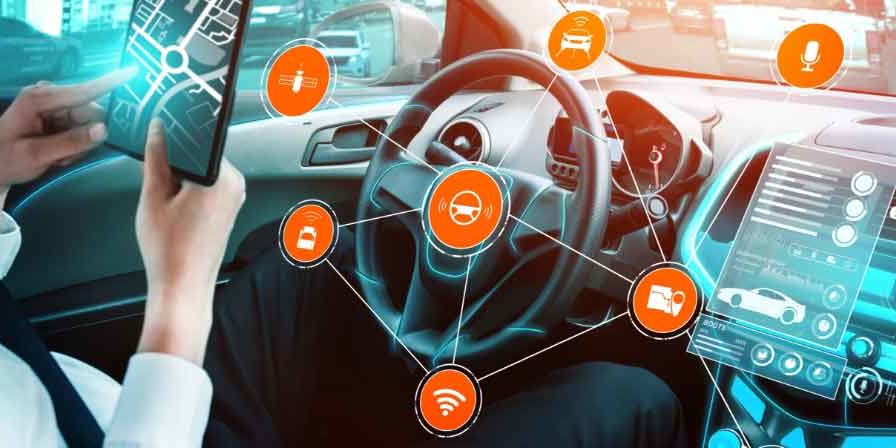So, what’s the solution? Jump back to classic cars’ concept, or mitigate the risks of cyber attacks in connected cars. Well, of course, draw out the risks. But, how? You may be wondering…The answer is by Ensuring Automotive IoT Security. Let’s know more in detail by having a look at the market –
A Brief View of the Market
The Automotive IoT market looks a bit interesting when we set our glance on the below statistics –
As provided in the report by Meticulous Research, the Automotive IoT Market is projected to hit the mark of USD 541.73 billion by the end of 2025, at a CAGR of 16.4% during the forecast period 2019-2025. This high-side projection owes its occurrence to the growing demand for connected vehicles, government initiatives for smart cities & intelligent traffic management systems, growing approvals & funding for autonomous vehicle testing, increasing demand for infotainment, real-time vehicle tracking system, and rising adoption of road vehicle safety solutions.
The thing to be noted in the projected growth of the Automotive IoT market is not just about advancement but also about the hidden risk of car attacks or security threats. Inculcating automation in the cars comes with the potential risk of car systems hijacking, wrong telemetry display on the dashboard, losing steering control to hijackers, engine switch off, and more. Here are mentioned in detail what security challenges does the connected cars face and how can they be overcome –
Connected Cars and Their Security Challenges
The below mentioned can be understood as the broad categories of the security challenges faced by the growing market of connected cars –
-
Vulnerability
As the connected cars would have to rely on third-party vendors for hardware and software, the security would definitely fall into the vulnerable category. Besides, a long product life cycle and supply chains make things more unprotected.
-
Broad Scope
A comprehensive and heavy scope of connected cars is also one of its challenges. As the car’s security depends on an integrated view of the vehicles, the network, and the backend, it needs to meet the demands of quickly evolving technology, requiring extensive knowledge and skills.
-
Uncontrollable Components
It becomes an uncontrollable and challenging task to manage the security risks brought about by vehicle owners’ actions, which can be as normal as installing new applications, components, etc.
-
Lack of Threat Intelligence
The Connected Cars find a deep need of recognizing and countering cyberattacks, summing up for sophisticated threat intelligence. But, the challenge here is the Threat Intelligence requires heavy investment which is found in constraints usually.
Connected Vehicle Ecosystem: Challenges-Specific Remedies
To grasp the challenges and their remedies better, here are presented the different components of the wide IoT range for the connected cars like Automotive Electronic Control Unit (ECU), Advanced Driver Assistance Systems (ADAS), and V2X communication systems. Have a glance at the numerous attack models and solutions against each of these elements:
-
V2X Communication

Being a critical component for the intelligent automotive ecosystem, V2X infrastructure is loaded by various interfaces equipped with different wireless technology provisions like BLE, ZigBee, Bluetooth, LTE, 5G, etc. Any compromise in the adoption and implementation of V2X communication can lead to road fatalities. The communication requires to be encrypted and guarded using Public Key Certificates with signed messages. This process allows for sender identity authentication and the signed messages to be changed regularly and have a shorter validity period to secure wireless communication. V2X Communication is such significant as the hackers can effortlessly target the communication channels and exploit the data presented to the drivers with incorrect/foul traffic updates and fallacious distances of the next car.
-
ADAS
Advanced Driver Assistance System (ADAS) plays a direct role in impacting passenger safety. If there’s any flaw in the ADAS cybersecurity measures, it could lead to fatal injuries and even passengers’ death. It includes different sensors such as radar, ultrasonic, LiDAR, and camera, which sums up the precise 360-degree depiction of the car’s surroundings. It can also be rightly stated that the algorithms camera image analysis, besides the sensor fusion and video processing driven by neural networks or deep learning systems, are exposed to cyber-attacks. ADAS threats can be mitigated when sensor fusion and image analysis algorithms are secured periodically by undergoing practices like threat analysis and risk assessment on the vulnerable assets.
-
Automotive ECU
Automotive Electronic Control Unit (ECU) is connected wired or wirelessly to communicate with each other for different automotive aspects like engine telemetry, brake, adaptive cruise control, park assist, etc. Moreover, they can communicate with various networks like CANbus, MOST bus, or FlexRay. Threat models of automotive, based on real-world attacks and theoretical attacks can be employed to mitigate the risks of security in this case. Real-world attacks can be those that are linked with a car’s physical properties such as steering, braking, parking, etc., endangering passenger safety. In contrast, theoretical attacks could be associated with hacking the GPS data, radio signals, and multimedia systems, compromising patient privacy.
The Final Lines
Hence, it could be known that Automotive IoT Security stands of utmost importance when it comes to the sprawling market of the connected vehicle ecosystem. Moreover, with the rise in the autonomous cars industry’s innovations, the security of smart cars has proven to be highly essential in every facet of life. Get to know more regarding the Automotive IoT Security and the related, with Teksun’s team of industry professionals that are adept in the Automotive domain.



